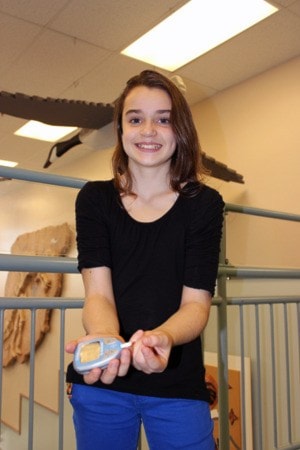Aspen Park Elementary student Payton Gartside, 10, has lived with Type 1 diabetes (T1D) since she was two — making her life very different from other children her age.
November is National Diabetes Awareness Month, and according to Payton's mother Mackenzie Gartside, who is the North Island representative for the Juvenile Diabetes Research Foundation (JDRF), the impact T1D has had on Payton's life is considered fairly normal for children with the disease.
Payton is somewhat restricted from extended outings like sleepovers and school field trips because she must check her blood sugar levels eight to 12 times per day, monitor her diet closely and receive insulin regularly.
"She's definitely a little bit more independent with all of her site changes and eating habits and such now," says Mackenzie, adding it was more difficult when Payton was younger and Mackenzie had to personally check her blood sugar levels every two hours, even through the night.
"I don't have to test her every two hours anymore … but if I've missed that four in the morning slot you kind of walk in, and you just kind of watch her, and see if her, if she's breathing, because it can happen — they just don't wake up, their blood sugar drops in the middle of night and they just don't wake up."
T1D is an autoimmune disease, which stops a person's pancreas from producing insulin, which is a hormone the body uses to turn food into energy. About 300,000 Canadians have the disease.
Payton has a portable insulin pump hooked up to her body at all times to manage her blood sugar levels. As we sit in the school library, she lifts up her shirt to show the injection site on her back where she has a catheter inserted.
She then pulls the pump out of her pocket, which has a tube of insulin in it, and starts explaining a complex system for tracking her blood sugar level and monitoring how much insulin she needs.
Mackenzie later explains Payton didn't always have this pump so she had to have insulin injections instead. She adds the insulin pump cost the family about $7,500, plus another $50 every three days or so for ongoing costs.
Payton also displays her fanny pack — which is filled with emergency items and she must have with her 24/7 — and her device for checking her blood sugar level. The strips she puts her blood on to test cost $1 each but because she tests her blood eight to 12 times per day this seemingly minor expense can add up, too.
Payton says T1D can make it difficult for her to focus sometimes.
"When I'm low it's hard to focus," says Payton, adding "and I kind of get like shaky and wobbly, and my legs are like really — they feel like they can't move — and then I get really, really hungry."
Mackenzie notes JDRF is working towards finding solutions to help manage the disease such as new monitoring devices and implants to help keep blood sugar levels more stable for diabetes sufferers.
She says JDRF is also working towards a cure for T1D, and she hopes it will be able to develop a vaccine.
To donate to JDRF, visit www.jdrf.ca.
writer@comoxvalleyrecord.com
